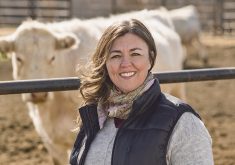You can’t always rely on one-off farm tours to get the info you need to make those critical decisions for your farm. One increasingly popular solution: peer groups. Here’s how to get one started.
– April Stewart, CG Associate Editor
Every farmer gains deep perspective and a wealth of insight during their career. It’s knowledge that comes from personal experience, family and advice from trusted advisors. And, of course, farmers are also adept at learning from each other.
Read Also

Youth focused on keeping Quebec’s dairy industry strong
In part two of our Making the Future series, Country Guide spoke with Béatrice Neveu from Rawdon, Que. (Read part…
This latter takes place over the fence, but it is also structured, with a long history of farm visits, crop bulletins and so much more being offered by commodity groups and local associations, co-ops and clubs.
But as times change, you can’t always get what you need on a crop tour. Today, farmers are looking to hone their business management skills, which aren’t as easy to check out as a new barn. And they’re looking for unbiased sources of business advice and information, which are also harder to find.
It’s why there’s a new type of farmer-led group emerging in Canadian agriculture — the peer advisory group.
It’s no secret Terry Betker, Manitoba-based CEO of Backswath Management, is a big believer. After helping put peer advisory groups together and run them, he’s in demand as a speaker talking about how farmers can organize, structure and operate these groups.
He’s also been sharing what participants tell him about how joining their group has added value to their farm business and helps them run their farms better.
What he hears is that farmers find peer groups are an invaluable source of expertise, and they learn of other’s experiences and gain insights they can use to make better decisions. Peer groups also give these farmers a sort of panel that they can take their ideas to, or seek advice on specific questions.
Peer advisory groups have been commonplace in business generally, yet less so in agriculture, at least until now.
The drive now is coming mainly from farmers who are looking to position their farms for the future, and who want to elevate their financial performance, Betker says. As their farms become both increasingly sophisticated internally, and face ever more complex externalities, they’re hungry for insight.
At the same time, it’s more difficult than ever for them to find third-party sources of information for the specific questions they’re trying to answer.
“But generally, it’s because farmers are more proactively looking at managing their businesses,” Betker says.
Those forming peer groups are looking to their peers as trusted sources who understand farming, he says.
“They want to have a network or group of other farmers that they can learn from,” Betker says. “They look to that interaction, to present the challenges and opportunities they’re encountering, and hear what other farmers have to say about it.”
It’s impossible to pinpoint precisely how many now operate because peer groups can and do come in many different forms. And there is no right or wrong way to organize one, of course, although Betker finds added value in those that are formally organized, meet regularly and agree to a structure that is facilitated by someone external to the group.
The first step
Getting a group together takes some time, and the first meeting can actually be the most difficult to arrange.
But how it looks is entirely up to those putting it together, including deciding on what an optimum number is. Some groups are quite small; others have multiple members, says Betker.
The actual membership is also a decision to make as a group. In the groups Backswath Management facilitates, some come looking for peer group interaction with a similar age peer group, while others prefer a mix of ages. “The peer groups that I’ve had personal experience with have had men and women, younger families and more mature families, mothers and fathers and daughters and sons, partners, brothers, cousins — a broad demographic,” he says.
Once a group of people has been assembled — and it can be across any geographic distance of the group’s choosing — these groups then solidify their purpose and clearly define their mission, vision and goals. This is where the group agrees on what topics members want to focus on. Some peer advisory groups focus on single issues such as succession. Others choose a broad scope.
Confidentiality
Formally organized peer advisory groups also take the critically important step of ensuring confidentiality to build trust and ensure that what is talked about in the group will not be shared beyond the group. There are ground rules that everyone needs to agree to, and one is that you’re not going to break confidentiality, says Betker.
Again, this requires laying down ground rules that you’ve agreed to not to talk about one another’s business outside the group, and the expectation of the group is that no one break those rules. This is about group management and setting down the rules and processes for it, he says.
The most successful peer advisory groups are those made up of people who share a mindset that they’re going to benefit from peer interaction.
To get maximum benefit from one, you’re someone who accepts you don’t have all the answers, and you’re willing to talk about the mistakes you’ve made, he says. Essentially, you have to be willing to open up and show your vulnerable side, says Betker. What you can expect back from like-minded people in the group is that you will not be criticized or judged. When you’re talking about a new strategy or plan you can expect to have questions asked of you, but again, not in a judgmental or critical way, he says.
That’s where you learn from the group, and where those in your group can learn from you.
These groups aren’t “feel good forums,” either, however.
The value farmers say they get from them is when others ask questions about how you manage your business.
“I think the benefit really increases when we can drill down into ‘why are you doing that?’” he says. “You shouldn’t have everyone just telling everyone else what a great job they’re doing. You should expect that someone will provide critical insight or ask probing questions about the business.”
“But, again, they shouldn’t be asked in a judgmental form, where anyone would feel chastised for something they did or didn’t do,” he adds.
Contribute equally
A key role an external facilitator plays is keeping the group on track and ensuring everyone has equal input to discussions. Groups don’t work when some do all the talking and others don’t or can’t contribute.
“Every member should be expected to come and make a contribution to the meeting and everyone should be able to expect to take something away from the meeting,” says Betker. A group with those not contributing don’t benefit from that member, he says.
“The group is not going to thrive.”
Is it for you?
Peer groups don’t work for everyone, of course. And one hesitation Betker does hear is that farmers aren’t sure who their “peers” actually are. Besides, peer groups benefit from multiple perspectives.
“If you had everyone that’s exactly the same I don’t think you’d benefit from the group,” he says.
Generally, what it boils down to is not so much about what kind of farm business you have, but how you prioritize management of the business, says Betker. “It’s got less to do with size or how sophisticated the business is. It’s got more to do with how they think about their business and the management of it.”
Usually a group has cohered by a third meeting, he says.
“It takes three meetings before I get the sense that the relationships and the trust really starts to become entrenched in the group,” he says. At that point, the discussions deepen.
Having an agenda is critical. It’s a diverse range of topics for the more broadly focused peer advisory groups. Production issues, cost control measures, compensation of farm staff and time management are frequent discussion topics.
“There’s lots of discussions around land and rent and buy strategies,” says Betker. Benchmarking of financial performance, wages, agronomy and professional fees are also common meeting topics.
“All benchmarking does is create context, how someone else does it if it works for you,” he says. “They compare amongst themselves how they manage different parts of their business.”
As trust builds, group members will also talk over personal challenges.
As for what participants ultimately get from participating, the feedback he’s heard is that they improve their business management.
“We’ve had enough experience over a long enough period of time to draw the observation that through peer group interaction they have absolutely advanced their management practices,” Betker says. “Everybody is going to take what’s significant to them, given where they’re at and apply it.”
– This article was originally published in the February 18, 2020 issue of Country Guide.















